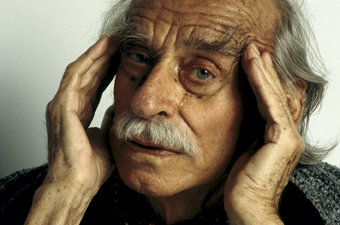Lessons from Bernard Rudofsky
dal 3/7/2007 al 29/9/2007
Segnalato da
3/7/2007
Lessons from Bernard Rudofsky
Canadian Centre for Architecture CCA, Montreal
The first retrospective to examine the life and work of the controversial architect, designer, and critic whose groundbreaking buildings, exhibitions, and fashion designs challenged the Western world's perceptions of comfort and culture. The show highlights the diverse contributions of a unique and underappreciated pioneer of modernism, and brings to light the relevance of Rudofsky's principles today.

Retrospective
curated by Monika Platzer and Wim de Witt
Lessons from Bernard Rudofsky is the first retrospective to examine the life and work of the controversial architect, designer, and critic whose groundbreaking buildings, exhibitions, and fashion designs challenged the Western world’s perceptions of comfort and culture. A collaboration between the Architekturzentrum Wien and The Getty Research Institute in association with the CCA, the exhibition highlights the diverse contributions of a unique and underappreciated pioneer of modernism, and brings to light the relevance of Rudofsky’s principles today.
The exhibition spans the entire career of Bernard Rudofsky (1905–1988), including his roots in the early years of European modernism; his world travels, which shaped his views as a designer and critic; and his influence as a curator and writer on international discourse on architecture, fashion, and design. The underlying motivation that unified Rudofsky’s work was what he saw as a loss of sensual awareness in all aspects of modern life. Rudofsky is perhaps best known for the exhibitions and publications that he conceived in the second half of the twentieth century. The most famous of these is Architecture Without Architects, the landmark book and exhibition at the Museum of Modern Art (MoMA), New York (1964), which toured for 11 years and was presented in more than 80 venues around the world. Carefully researched and visually engaging, Architecture Without Architects challenged conventional notions of architecture and dwelling through its study of vernacular building technologies and alternative ways of living. Rudofsky’s openness to different social and architectural traditions and his recognition of the sensory dimensions of the environment continue to be of great relevance for architecture and urbanism today.
As an architect, Rudofsky employed a modernist vocabulary – with its characteristic white, undecorated, cubic shapes in concrete and glass – yet at the same time he was an outspoken critic of modern architecture. He rejected the notion of universal or standardized concepts of dwelling and instead promoted the idea that an individual’s built environment should reflect the history, culture, and climate of his or her immediate surroundings. Architecture, for Rudofsky, was “not just a matter of technology and aesthetics but the frame for a way of life – and with luck, an intelligent way of life.”
The exhibition offers a comprehensive view of Rudofsky’s work and the life he shared with his wife and collaborator, Berta Rudofsky (1910-2006). Over 200 works are on view, including original drawings, watercolours, photographs, and densely filled notebooks from Rudofsky’s travels. The exhibition is organised in six thematic sections, beginning with Life as a Voyage, Travel as a Lifestyle. Sensuous Austerity: The Mediterranean and Japan maps the combined traditions that formed the basis of Rudofsky’s concept of an ideal home and his attitude toward life.
His architectural work and his ideas of dwelling are explored in The House, an Instrument for Living and Casa Procida, a Manifesto, on his designs for a house on the Italian island of Procida. The Unfashionable Human Body, related to his book of the same name and the MoMA exhibition Are Clothes Modern? (1944), includes studies for clothing and samples of his textile designs and Bernardo Sandals (1946-64). Finally, A Natural History of Architecture addresses Rudofsky’s interest and study of vernacular architecture, and offers a rare view of the original photographic panels created for Architecture Without Architects at the MoMA. Lessons from Bernard Rudofsky also features a reading area where original editions of his publications are available for viewers to consult, such as Behind the Picture Window (1955), Streets for People: An American Primer (1969), and The Prodigious Builders (1977).
These are accompanied by influential books on architecture, cities, and dwelling from the same period, as well as a selection of Rudofsky’s articles published in Domus (1937-38), of which he served as editor. Audio and video excerpts provide views of his architectural projects as well as rare radio interviews with Rudofsky himself. The objects featured in Lessons from Bernard Rudofsky derive mainly from the Rudofsky archive at The Getty Research Institute as well as the Bernard Rudofsky Estate in Vienna. The exhibition is designed by Margot Fürtsch and Siegfried Loos of architecture firm Polar÷, with graphic design by Gabriele Lenz.
Lessons from Bernard Rudofsky is curated by Monika Platzer, Curator, Archive/Collection at the Architekturzentrum Wien, and Wim de Wit, Head of Special Collections and Visual Resources and Curator of Architectural Collections at The Getty Research Institute. The exhibition is presented at the Architekturzentrum Wien in Vienna, Austria, from 8 March to 28 May 2007 and, following its presentation in Montréal, travels to The Getty Research Institute, Los Angeles, USA, from 11 March to 8 June 2008.
The exhibition is accompanied by a 296-page catalogue with contributions by Andrea Bocco-Guarneri, Monika Platzer, Felicity D. Scott, Wim de Wit, Maria Welzig, and includes forewords by Thomas Crow, Director of The Getty Research Institute, Architekturzentrum Wien Director Dietmar Steiner, and CCA Director Mirko Zardini. A selection of Rudofsky’s visual and text contributions to Domus are also reproduced and translated. Published by the Architekturzentrum Wien and The Getty Research Institute in English and German editions, Lessons from Bernard Rudofsky is lavishly illustrated with over 200 black and white and colour images including full-page reproductions of Rudofsky’s photographs. The English edition is available at the CCA Bookstore.
Opening july 4, 2007
Canadian Centre for Architecture
1920, rue Baile - Montreal



